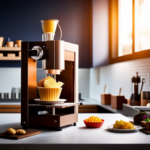Imagine creating intricate, delectable treats with just the touch of a button. Welcome to the world of 3D printing edible delicacies. This revolutionary technology has opened up a whole new realm of culinary possibilities, allowing for the customization and creation of edible masterpieces.
In this beginner’s guide, we will delve into the intricacies of 3D printing technology, explore the selection of edible materials, and provide essential tips for successfully bringing your delectable designs to life.
Understanding 3D Printing Technology
Understanding the intricacies of 3D printing technology is essential for successfully creating edible delicacies using this innovative method. The 3D printing process involves the layer-by-layer deposition of material to create a three-dimensional object.
When it comes to edible 3D printing, the choice of edible filament options is crucial. Various materials can be used as edible filaments, including chocolate, sugar, fondant, and even dough. These filaments are carefully extruded through a nozzle onto a build platform, following a precise digital design.
The 3D printing process allows for intricate and customizable designs, making it ideal for creating unique and artistic edible creations.
One of the key advantages of 3D printing technology in the culinary world is the ability to produce complex shapes and structures that would be challenging to achieve using traditional methods. Additionally, 3D printing allows for precise control over ingredient placement, potentially leading to new textures and flavor combinations.
As the technology continues to advance, the range of edible filament options is expected to expand, offering even more possibilities for creating delectable 3D printed treats.
Choosing Edible Materials for Printing
The selection of edible materials for 3D printing is a critical aspect that profoundly influences the outcome of the printed delicacies, allowing for a wide range of customizable options and intricate designs. When choosing edible materials for 3D printing, several factors must be considered.
-
Edible Ink: Specialized edible ink cartridges are used in 3D food printers to create colorful and intricate designs on edible surfaces.
-
Food Safety Regulations: It is crucial to ensure that all edible materials used in 3D printing comply with food safety regulations to guarantee the safety and quality of the printed delicacies.
-
Edible Substrates: Various edible substrates such as chocolate, sugar, and dough can be used as the base material for 3D printed edible creations.
-
Flavorings and Colorings: Edible flavorings and colorings can be added to the printing materials to enhance the taste and visual appeal of the final products.
-
Edible Support Materials: Some 3D printed delicacies may require edible support materials to ensure intricate designs and complex structures are maintained during the printing process.
The careful selection of edible materials is essential for achieving the desired outcomes in 3D printed edible delicacies. Moving on to the subsequent section, it is important to understand the essential tools and equipment for 3D printing.
Essential Tools and Equipment for 3D Printing
When it comes to 3D printing edible delicacies, the process requires the use of specialized tools and equipment for precise and controlled fabrication. Ensuring 3D printing safety and maintaining the printer are essential aspects of the process.
To guarantee safety, it is crucial to use food-grade materials and tools specifically designed for 3D printing edible items. These include food-safe 3D printers, stainless steel or food-grade plastic extruders, and specialized printing nozzles. Additionally, it is important to have dedicated equipment such as food brushes, spatulas, and cleaning tools to maintain hygiene during the printing process.
Printer maintenance is vital for producing high-quality edible prints. Regular cleaning and maintenance of the printer, especially the extruder and nozzles, are crucial to prevent contamination and ensure the safety of the printed food items. Furthermore, it is essential to follow the manufacturer’s guidelines for maintaining the 3D printer, including regular lubrication, calibration, and inspection of components.
Adhering to these maintenance practices not only ensures the safety of the printed delicacies but also prolongs the lifespan of the 3D printer.
Designing and Customizing Edible Creations
To achieve precise and intricate designs for edible delicacies using a 3D printer, it is essential to employ specialized software that allows for meticulous customization and detailing, ensuring the creation of visually stunning and delectable treats.
When designing and customizing edible creations, consider the following:
- Customized Flavors: Utilize software to experiment with different flavors, creating unique combinations tailored to individual preferences.
- Unique Shapes: Explore the possibilities of 3D printing by designing custom shapes that are not achievable through traditional methods.
- Texture Variation: Adjust the texture of the edible creations to enhance the sensory experience, from smooth to crunchy or soft to firm.
- Interactive Designs: Incorporate interactive elements into the designs, such as hidden compartments or moving parts, to surprise and delight consumers.
- Personalization: Use the software to personalize each creation, adding names, dates, or messages to make them truly special.
These considerations allow for the creation of truly customized and innovative edible delicacies that go beyond traditional baking and confectionery methods.
Transitioning into the subsequent section about ‘tips for successful 3D printing of edible delicacies’, it is important to understand the technical aspects of the printing process to ensure the best results.
Tips for Successful 3D Printing of Edible Delicacies
Transitioning from the considerations for designing and customizing edible creations, achieving successful 3D printing of edible delicacies requires a comprehensive understanding of the technical aspects involved in the printing process.
Firstly, it is crucial to select the appropriate printing techniques for the specific food material being used. Depending on the viscosity and texture of the edible material, different printing methods such as extrusion-based or powder-based printing may be more suitable.
Troubleshooting during the printing process is also essential. This involves ensuring proper calibration of the 3D printer, maintaining the right temperature for the food material, and adjusting the printing speed to achieve accurate and consistent results.
Moreover, food safety and regulations play a vital role in the 3D printing of edible delicacies. It is imperative to use food-grade materials and adhere to strict hygiene practices throughout the printing process.
Additionally, understanding the regulations and guidelines set forth by food safety authorities is crucial to ensure that the printed edibles meet the required standards for consumption.
Frequently Asked Questions
Can 3D Printed Edible Delicacies Be Safely Consumed by People With Food Allergies?
3D printed edible delicacies should be consumed with caution by individuals with food allergies. Cross-contamination risk exists during production. Ingredient sourcing and allergen labeling regulations are crucial for safety. Consult a healthcare professional for advice.
How Do You Clean and Maintain a 3D Printer Specifically Used for Printing Edible Items?
To ensure the safety and quality of 3D printed edible items, meticulous cleaning procedures are imperative. Regular maintenance schedules, including thorough disassembly and sterilization, are essential for preventing cross-contamination and ensuring compliance with food safety standards.
Are There Any Specific Regulations or Guidelines to Follow When Selling or Serving 3D Printed Edible Creations?
When selling or serving 3D printed edible creations, it’s crucial to adhere to food safety regulations to ensure consumer health. Additionally, understanding liability and selling restrictions is essential to navigate the legal landscape.
Can You Use Any Type of Food Coloring or Flavoring in the Edible Materials for 3D Printing?
When 3D printing edible creations, it is essential to consider food safety and printing materials. Utilizing food-grade color and flavor during the printing process ensures compliance with health standards, guaranteeing a safe and palatable end product.
How Long Can 3D Printed Edible Delicacies Be Stored Before They Start to Degrade in Quality or Taste?
The storage duration of 3D printed edible delicacies can vary based on ingredients and environmental conditions. Properly sealed and stored in a cool, dry place, these items can maintain flavor preservation for up to several weeks.
Conclusion
In conclusion, 3D printing technology has revolutionized the creation of edible delicacies, offering endless possibilities for customization and design.
By carefully selecting edible materials and utilizing the essential tools and equipment, individuals can create intricate and unique culinary masterpieces.
With attention to detail and creativity, the potential for 3D printing in the culinary world is limitless, allowing for the creation of delectable treats that are as visually stunning as they are delicious.
Embrace the future of food innovation with 3D printing.


